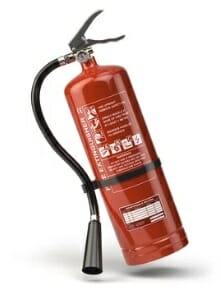When a fire breaks out, the correct use of a fire extinguisher can be the difference between a minor or a major loss. As we all know, fire requires fuel, heat and oxygen to burn. With the use of a fire extinguisher, we are able to apply an agent that will cool burning heat, smother fuel or remove oxygen so the fire cannot continue to burn. That is why when used properly, fire extinguishers can help control a small fire until emergency responders arrive. However, if they are not used correctly, they can actually make the fire worse. Today’s discussion targets the proper means and methods for using fire extinguishers.
- Use the right type of fire extinguisher
- Ensure your fire extinguisher is properly inspected
- Understand the limitation of your fire extinguisher
- Use the PASS Method when extinguishing fires
USE THE RIGHT TYPE OF FIRE EXTINGUISHER
There are four classes of fire extinguishers A, B, C and D. Each class can put out a different type of fire. Class A extinguishers are to be used when extinguishing fires of ordinary combustibles including wood, cloth, rubber, paper, as well as many plastic materials. Class B extinguishers are for use on flammable liquids like grease, gasoline, solvents, lacquers, alcohols, oils and other similar substances. Class C extinguishers are suitable for use only on electrically energized equipment fires. Class D extinguishers are designed for use on flammable metallic substances like potassium and sodium. Multipurpose extinguishers can be used on different types of fires and will be labeled with more than one class, for example A-B, B-C or A-B-C. You can find the class label of most fire extinguishers in a pictograph on the side of the extinguisher.
ENSURE YOUR FIRE EXTINGUISHER IS PROPERLY INSPECTED
Fire extinguishers require 2 types of documented inspections, monthly and annual. Both of these inspections should be properly logged with a tag on the unit. The monthly inspection is to be conducted by the responsible competent person. When doing so, we should be verifying the locking pin is intact and the tamper seal is unbroken as well as looking for obvious physical damage, corrosion, leakage, or a clogged nozzle. Next, we need to check that the pressure gauge or indicator is in the operable range or position, and that the extinguisher is still full. Lastly, we want to make sure the operating instructions on the nameplate are legible and facing outward, and that the annual and monthly inspections are in date. Unlike the monthly fire extinguisher inspections, the annual inspections must be administered by a licensed fire protection company per NFPA. Every FMC should have a provider to conduct the annual inspections. If you need help finding a location to conduct annual inspections, please contact the OneSafety team for assistance.
UNDERSTAND THE LIMITATIONS OF YOUR FIRE EXTINGUISHER
It is important to know the limitations of your fire extinguisher before you have to use it and put yourself in danger. Knowing the model and weight of the extinguishers located in your work area is crucial information. A dry chemical fire extinguisher such as the common “ABC” red extinguishers will reach a distance between 5 and 20 feet. A 10 lb. to 20 lb. dry chemical fire extinguisher will last anywhere from 10 to 25 seconds. The length of time the extinguisher can be used depends on the model type and weight. Make sure you are familiar with how long the available extinguisher will last. Fire extinguishers are designed to fight small fires. This means the fire should be about the size of a small trash can if you are looking to extinguish it with a basic fire extinguisher. If it is any larger, don’t put yourself in harm’s way and call 911 for assistance.
USE THE PASS METHOD WHEN EXTINGUISHING FIRES
If you need to use a fire extinguisher, remember the P.A.S.S method for how to use it safely and effectively. Each letter represents one of the four steps to use the fire extinguisher. P = Pull the pin. Grab the extinguisher, hold it away from your body, and release the lock pin. A = Aim. Aim the extinguisher towards the base of the fire (always aim it at the base and not the flames or smoke as this won’t put the fire out). S = Squeeze. Slowly squeeze the lever while it is pointed at the base of the fire. S = Sweep. Move the extinguisher side to side while squeezing the lever until the fire is out.
Fire extinguishers are an important part of any workplace safety plan, and it is essential that everyone understands how to use them correctly and safely. Failure to execute on the items discussed today may result in property damage or injury.
If you would like more information on this topic or any other safety-related topic, please reach out to the Ontivity safety team at safety@ontivity.com, and we will get you taken care of.









